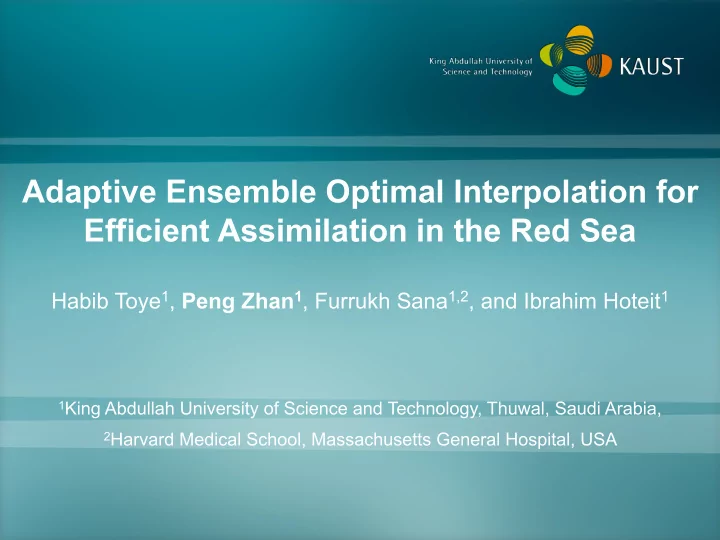

Adaptive Ensemble Optimal Interpolation for Efficient Assimilation in the Red Sea Habib Toye 1 , Peng Zhan 1 , Furrukh Sana 1,2 , and Ibrahim Hoteit 1 1 King Abdullah University of Science and Technology, Thuwal, Saudi Arabia, 2 Harvard Medical School, Massachusetts General Hospital, USA
Introduction – The Red Sea • Extensive evaporation (>2m/year) • One of the warmest and saltiest water masses in the world 2 nd longest and 3 rd largest coral reef system • • Commercial highway • Source of food, water, and energy • ARAMCO is exploring it … • Impact on regional climate • Build an integrated data-driven modeling system to study and predict the Red Sea circulation 1
Model and Data • MITgcm 0.04 ° 28 o N • ECMWF atmospheric forcing/ ECCO2 OBCS 24 o N • Along-track merged SSH (RADS) every 3 days 20 o N • 3-day midnight SST (AVHRR) 16 o N • Data Assimilation Research Testbed ( DART ) 12 o N 32 o E 36 o E 40 o E 44 o E 48 o E 2 [ aviso.altimetry.fr , 2014]
Ensemble Kalman Filter (EnKF) EAKF 𝒈 − 𝒀 𝒈 + 𝒀 𝒃 𝒃 = 𝑩 𝑼 𝒚 𝒋 𝒚 𝒋 ! ! = ! − ! ! ,𝟐 𝚻 𝒈 ,𝟐 + 𝑰 𝑼 𝑺 ,𝟐 𝑰 𝜯 𝒃 = 𝚻 𝒈 ,𝟐 𝒀 𝒈 + 𝑰 𝑼 𝑺 ,𝟐 𝒛 𝒀 𝒃 = 𝚻 𝒃 ! = ! ! ! + ! ( ! ! − ℎ ( ! ! ! ) ) ! ! 3
Ensemble Optimal Interpolation (EnOI) forecasts model advance analysis model advance Time 1 3 2 4 Assimilation cycles (update + forcast)
Seasonal Variability Yao et al. (2013 a, b) Smeed et al. (2004) 5
DEU -- Adaptive EnOI Forecast step: integrating only ONE mean at the forecast step. Before analysis: building the forecast ensemble by adding the anomalies to the forecasted mean. 6
Seasonal EnOI En1 En2 En3 … En10 En11 En12 Monthly dictionary January February March … October November December LONG TERM SIMULATION … … Conventional EnOI … … Seasonal EnOI
Other DEU Schemes To update the ensemble X = [d j1, …, d jN ] at every assimilation step based on the latest forecast Through L2 norms on SST • To select the members that are closest to the forecast Through an Orthogonal Matching Pursuit (OMP) • OMP finds the members most correlated with the current residuals. (orthogonal projection of the signal onto the subspace spanned by the set of members selected so far) 8
Ensemble Spread (Feb-6-2006) • EAKF shows smaller spreads in SSH, SST and temperature profiles • DEU exhibits stronger eddy variability in the spread, suggesting the selected members describe different features of eddy activities 9
Distribution of SSH (Feb-6-2006) • Ensemble spread is small in EAKF and yeilds less increments • • As anomaly of mean flow, eddies information is described by P f and can be introduced 10
Schemes comparison SST SSH • EAKF has larger analysis RMSE than DEUs, due to the small ensemble spread • DEU analysis SSH RMSEs are comparable to AVISO • SSH RMSEs are computed against different sparse obs from what have been assimilated (nums & locations) 11
Statistics of SST (Feb-6-2006) SEnOI L2 OMP 12
Why larger ensembles? Having more members enables: • Additional error directions (increased rank in P f ) • More robust correlations, and may be less localization • Better maintained ensemble spread, less inflation Dual experiments have been carried for EAKF with ensemble size of 100 V.S. 1,000 (Forecast only: 22,000 3-day MITgcm runs 1100 members for 60d = 1 member for ~180yr) 13
Prior Correlation - SST 1000 members 100 members 100 members with cutoff 14
Prior Correlation - SSH 1000 members 100 members 100 members with cutoff Long-range correlations vary in different variables, time, and locations, 15 define adaptive localization scales for different variable?
Prior Distribution A larger ensemble seems to make the Monte Carlo-based approximation of the prior distribution more Gaussian. 16
RMSE The experiment with 1000 members has larger ensemble spread and smaller RMSE. 17
To Summarize • The DEU schemes (SEnOI and L2) are able to provide reasonable performance in the data assimilation experiments, at a small fraction of computing cost of EAKF. • EAKF with a larger ensemble size could significantly reduce the spurious correlations, keep ensemble spread, and exhibit a more Gaussian prior, but it is too expensive! • Next: Hybrid-DEU with large ensembles 18
Thank you!
Recommend
More recommend